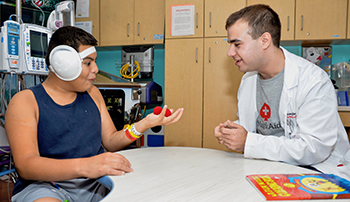Research Proves Magic Therapy Works
A study of MagicAid magic therapy shows it calms young patients

Medical student magic therapist, Harrison Pravder, engaging a pediatric patient in magic therapy at Stony Brook Children’s.
MagicAid magic therapy at Stony Brook Proven to Reduce Anxiety of Pediatric Patients and their Parents
Experiencing stress and fear is common among hospitalized pediatric patients. A new study of these patients at Stony Brook Children’s Hospital reveals that MagicAid magic therapy, an interactive therapy involving magic tricks and magic sessions, helps to significantly reduce both patient and parent/caregiver anxiety by about 25 percent. The findings, to be published in Hospital Pediatrics, suggest that a magic therapy program for pediatric inpatient care may have great value to hospitalized patients and their caregivers, and should be considered to be implemented in this setting.
The magic is performed by first- and second-year medical students, called Magic Therapists, at each patient’s bedside. The tricks are simple, classic ones: coins and balls appear and disappear, the Magic Therapist accurately “reads” the subject’s mind, individual red, white and blue silk handkerchiefs transform into an American flag, among others.
To help put young patients and their family members at ease, the Magic Therapists swap their traditional white coats for MagicAid t-shirts. They also incorporate everyday items, such as rubber bands and pocket change, into their routines. The therapists visit the children three times a week and are able to see between five and 10 patients over the course of an hour.
The program is offered by MagicAid, a non-profit organization co-founded by Harrison Pravder, a fourth-year medical student at the Renaissance School of Medicine at Stony Brook University. The program is run at Stony Brook Children’s under the guidance of professionals in the Child Life Program, who are responsible for identifying the children who they feel would benefit from the therapy.
“It is important to develop tools to facilitate coping and encourage distraction for patients due to anxieties associated with hospitalization,” said Pravder, who plans to specialize in pediatric anesthesiology. “Anxiety often arises due to loss of self-determination and separation from home and family in patients, while, for parents, stress is often related to their child’s hospitalization and other concerns such as financial costs, and this stress can translate back to the child.”
Pravder and his colleagues found a majority of patients and parents to be receptive to magic therapy and willing to participate. They evaluated 100 inpatients, ages 5 to 16 years, and 90 caregivers at Stony Brook Children’s. Patient-caregiver pairs were randomly assigned to a magic therapy intervention group or control group. The magic therapy included a session of watching and engaging in magic, learning how to perform a magic trick, and receiving a magic prop to practice in order to perform for others.
Anxiety was measured before and after the magic interventions by using validated self-report tools. These included a facial image scale and the Venham Picture Test for younger patients and, for older children, a pictorial scale and a written scale signifying anxiety levels. Caregivers’ anxiety levels were evaluated using only the written linear scale, called the short State-Trait Anxiety Inventory (STAI).
After analyzing the results, they found that the patient magic group’s standard anxiety was reduced by 25 percent after the magic therapy, and the caregiver magic group’s anxiety was reduced by 24 percent.
Part of the study included a questionnaire for health professionals designed to assess the usefulness of magic reducing anxiety and the feasibility of such a program in a healthcare setting. Based on the results of 37 physicians and nurses surveyed at Stony Brook on the topic, 98 percent recommended continuance of the program, 97 percent reported that the student magicians were not a disturbance in the healthcare setting, 81 percent reported that the activity is helpful to the child and 57 percent reported it as helpful to parents.
To learn more about MagicAid, visit www.magic-aid.org or facebook.com/magicaid.
